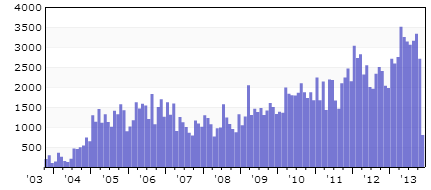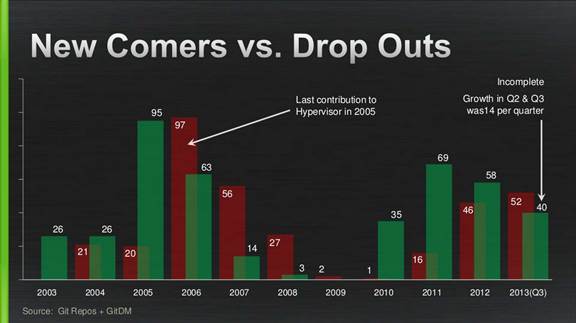AB Community Report/October 2013
From Xen
Jump to navigationJump to search
Overview
Xen Adoption
- The share of Xen based Hypervisor in Openstack has grown from 13% in April to 16% in October 2013 (sources: [1], [2])
- Xen adoption in automotive is building momentum (engagement with Linux Automotive WG / Genivi / Misc vendors, prototypes by misc suppliers, example: [3] & [4])
- Numerous discussions with prospective contributors from all sort of industry segments at Linaro Connect and ARM TechCon (I don’t yet understand all the business and technology drivers for this, BUT I hope that by getting a clear understanding on why this is happening we can replicate this for the x86 architecture)
- A large vendor is planning a set-top box product line based on Xen + ARM
Xen News in October
- http://www.pro-linux.de/news/1/20385/10-jahre-xen.html (10 years of Xen)
- https://joinup.ec.europa.eu/community/osor/news/spains-galicia-research-open-source-cloud-use-schools
- http://www.thehostingnews.com/softsys-launches-xen-powered-linux-vps-29859.html
- http://virtualization.info/en/news/2013/11/release-xen-4-3-1.html
- http://developer.rackspace.com/blog/welcome-to-performance-cloud-servers-have-some-benchmarks.html
Xen Project Advisory Board
- In the process of signing up two more members to the Advisory Board (ETA end of year)
- Conversations with two more prospective Advisory Board members (not likely to close until Q1 or Q2 2014)
- First meeting of Test Framework WG (minutes to follow)
- Critical mass to kick off Marketing and PR Working Group achieved
Xen Project Developer Community
- Xen 4.4 : Feature freeze passed (planned release in Q1 2014)
- Mirage OS 1.0 (release and press release now planned for 1st week of Dec)
- Xen Project Developer Summit Attendees (93 of 94 registered attendees turned up, approximately 20-25 gate crashers who had not registered and attended some sessions)
- Last year we had 110 attendees of 120 registrations (similar ballpark figure)
- Talks available at http://xenproject.org/component/content/article/9-uncategorised/159-xen-project-developer-summit-2013-videos-and-presentations.html
- Observations: this is our first EU event
- EU attendees 50%
- US attendees 20%
- Asia attendees 25%
- Other 5%
- Normally we have 50%-60% US attendees
- We suffered a little due to Separating out user summit, which cost us some attendees
- Linaro Connect and ARM Partner meeting the week after the summit
- LinuxCon EU and NA being only 1 month apart
- EU location and travel restrictions (many of the US based vendors/orgs only sent 1 or no attendees this year)
- Approximately 20 different vendors (exact number to follow) are interested in seeding a Xen + Android initiative to channel momentum (platforms: ARM & Intel, Action on Lars to facilitate this)
- Developer Community Pipeline
- First patch submissions for review to Xen Project by Verizon, Broadcom ... these are under review and are not yet appearing in codeline stats
- Statements of intent for code submissions by various vendors: Samsung (different business units), GlobalLogic, NEC and others
- October Industry Events
- Xen Project invited to give keynote at Huawei & Partner developer event in China
- Xen Project is organizing 2 days Virtualization & IaaS DevRoom at FOSDEM (Brusseles) with RedHat and OpenStack foundation (event size >5K attendees)
- Open World Forum Paris: Xen - Open Source Hypervisor Designed for Clouds 200 attendees
- LinuxCon EU
- Xen Project Lessons Learned (60 attendees)
- Securing your Xen based Cloud (70 attendees)
- Linux Automotive Summit, Fall
- Xen on ARM: Virtualization for the Automotive Industry (>150 attendees)
- A few more smaller ones, which I have not tracked
- Ongoing and Upcoming Xen Presentations at Events
- OpenStack Summit (several talks)
- BACD Usenix Lisa
- CentOS Dojo Madrid
- SuseCon (2 talks)
- OpenSuse Summit (2 talks)
- Upcoming Call for Papers
- Dec 01 : FOSDEM 2014 Virtualization and Iaas Devroom (https://groups.google.com/forum/#!topic/fosdem14-virt-and-iaas-devroom/04y5YkyqzIo)
- Dec 15: SCaLE 12x (https://www.socallinuxexpo.org/cfp/)
October Metrics
(user metrics to be supplied by Russell at a later stage)
xen-devel traffic
Note:
- Drop in November activity is due to Xen Project Developer Summit (essentially taking out a week of core hypervisor development in October)
Xen Hypervisor Commits
Notes:
- 2 new contributors in the last 30 days: 1 Academia, 1 new Samsung employee
- Note that Hypervisor commits are generally a factor of approx. 3 larger than XAPI commits (the reason for this is that we tend to commit patch series in one go as one commit, whereas XAPI uses GitHub for workflow which appears to result in more frequent but smaller commits)
- Again, the Developer Summit impacted commits in October
Notes:
- This graph shows 1st contributors vs. contributors who stopped being active in a given year
- Snapshot was taken on Oct 1st
- As long as the red column is lower than the green column from the previous year, the developer population is growing
- Note that since the snapshot has been taken, red columns for 2013 & 2012 have actually reduced slightly (this is due to drop-outs being defined as developers that have last contributed in year X; rationale: somebody who made their last contribution in 2012, but contributed again yesterday will disappear from the drop-out graph)
- The growth in developer population from 2010-2013 has been largely driven by development on Xen and Intel. This wave of growth is now slowly running out of steam. However PVH, HVM Dom0, XenGT and other emerging technologies have the potential to change this.
- I expect a similar growth pattern as a consequence of increased interest in Xen on ARM. Most of this activity has not yet hit the repository or we merely have statement of intents (lack of hardware is also constraining growth). Note that only 4 out the 40 newcomers in 2013 were actually working on Xen on ARM. Assuming more momentum is building around ARM (which is very likely), I expect an influx of newcomers to gather momentum in 2014.
- Conclusion:
- My prediction is that we will see a second wave of developer population growth, similar to that in 2010-2013, which will start in 2014. The expectation is that in part, this will be driven by the Xen on ARM and non-traditional server use-cases. Possibly also by technologies such as PVH, HVM Dom0, XenGT, …
- Growth of the developer population from 2010 - 2012 has been more sustainable than that of 2003 - 2007, where most entrants dropped out the year after they joined the community. In 2010 - 2013, retention has been much higher than in earlier periods.
- We are also seeing an increase in what I call occasional contributors (i.e. people that fix one or two issues and then disappear, and re-appear when they have issues again). We hardly had any of these type of contributors when the project was struggling. The consequence of this is that we will generally see a higher level of drop-outs going forward. With code freezes and releases in 2014 and 2015 expected to be close to the end-of-year boundary we are also likely to see more jitter between years (due to deferred commits).
Xen API Commits
Mirage OS Commits
Not easy enough to retrieve data at the moment




